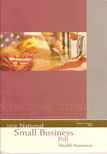Health Insurance
• In May 2003, 91 percent of small-business owners had health insurance for themselves. Approximately one-third obtained their coverage through their business. Nearly one-quarter purchased non-group coverage.
• Those owners without personal coverage were of two types. Forty-two (42) percent had been without coverage for 12 months or less. However, 28 percent lacked coverage for four years or more.
• Forty-eight (48) percent of small businesses offered health insurance to their employees. Forty-one (41) percent of those firms with fewer than 10 workers did so, but 78 percent of those with 20 or more employees provided coverage.
• Eighty-three (83) percent of small businesses with employee health insurance offered a single plan. Nearly three-fourths of these were some form of managed care. A preferred provider organization (PPO) was by far the most common plan type. However, small employers continued to be much more likely to offer traditional coverage than medium and large employers.
• The average small-business health insurance plan cost $402 per employee per month for single coverage and $732 per month for family coverage. The smallest firms paid lower premiums, probably due to less generous benefit packages.
• The majority of small businesses (55 percent) offering health insurance required no employee premium contributions for single coverage; one-third did not require them for family coverage. Respondents indicated that they require little or no premium-sharing in order to offer a competitive insurance program.
• Less than 10 percent of small businesses provided a flexible spending account to help shelter employee medical expenses from taxes. However, over 12 percent reimburse employees who purchase health insurance on their own. One in 20 had a medical savings account.
• Owner/operators of small businesses indicated three key reasons for offering coverage. They do it: “because it’s the right thing to do,” to attract and retain workers, and as a mechanism to obtain personal coverage.
• Owner/operators not offering coverage indicated that cost, lack of employee demand, and the ability of the owner to get coverage elsewhere were important considerations.


